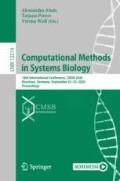Abstract
The impact of a given treatment over a disease can be modeled by measuring the action of genes on enzymes, and the effect of perturbing these last over the optimal biomass production of an associated metabolic network. Following this idea, the relationship between genes and enzymes can be established using signaling and regulatory networks. These networks can be modeled using several mathematical paradigms, such as Boolean or Bayesian networks, among others.
In this study we focus on two approaches related to the cited paradigms: a logical (discrete) Iggy, and a probabilistic (quantitative) one Probregnet.
Our objective was to compare the computational predictions of the enzymes in these models upon a model perturbation. We used data from two previously published works that focused on the HIF-signaling pathway, known to regulate cellular processes in hypoxia and angiogenesis, and to play a role in neurodegenerative diseases, in particular on Alzheimer Disease (AD). The first study used Microarray gene expression datasets from the Hippocampus of 10 AD patients and 13 healthy ones, the perturbation and thus the prediction was done in silico. The second one, used RNA-seq data from human umbilical vein endothelial cells over-expressing adenovirally HIF1A proteins, here the enzyme was experimentally perturbed and the prediction was done in silico too. Our results on the Microarray dataset were that Iggy and Probregnet showed very similar (73.3% of agreement) computational enzymes predictions upon the same perturbation. On the second dataset, we obtained different enzyme predictions (66.6% of agreement) using both modeling approaches; however Iggy’s predictions followed experimentally measured results on enzyme expression.
Access this chapter
Tax calculation will be finalised at checkout
Purchases are for personal use only
Notes
- 1.
All computations were performed on a standard laptop machine. Ubuntu 18.04, 64 bits, intel core i7-9850H CPU 2.60 GHz, 32 GB.
- 2.
- 3.
- 4.
- 5.
References
Thiele, S., Cerone, L., Saez-Rodriguez, J., Siegel, A., Guziołowski, C., Klamt, S.: Extended notions of sign consistency to relate experimental data to signaling and regulatory network topologies. BMC Bioinform. 16, 345 (2015). https://doi.org/10.1186/s12859-015-0733-7
Yu, H., Blair, R.H.: Integration of probabilistic regulatory networks into constraint-based models of metabolism with applications to Alzheimer’s disease. BMC Bioinform. 20, 386 (2019)
Cowell, R.G.: Local propagation in conditional Gaussian Bayesian networks. J. Mach. Learn. Res. 6, 1517–1550 (2005)
Yaghoobi, H., Haghipour, S., Hamzeiy, H., Asadi-Khiavi, M.: A review of modeling techniques for genetic regulatory networks. J. Med. Signals Sens. 2(1), 61–70 (2012)
Liang, W.S., Dunckley, T., Beach, T.G., et al.: Gene expression profiles in anatomically and functionally distinct regions of the normal aged human brain. Physiol. Genomics 28(3), 311–322 (2007)
Zhang, Z., Yan, J., Chang, Y., ShiDu Yan, S., Shi, H.: Hypoxia Inducible Factor-1 as a Target for Neurodegenerative Diseases. Curr. Med. Chem. 18(28), 4335–4343 (2011)
Ogunshola, O., Antoniou, X.: Contribution of hypoxia to Alzheimer’s disease: is HIF-1 \(\upalpha \) a mediator of neurodegeneration? Cell Mol. Life Sci. 66(22), 3555–63 (2009)
Downes, N., Laham-Karam, N., Kaikkonen, M., Ylä-Herttuala, S.: Differential but complementary HIF1\(\upalpha \) and HIF2\(\upalpha \) transcriptional regulation. Mol. Ther. J. Am. Soci. Gene Ther. 26(7), 1735–1745 (2018)
Folschette, M., Legagneux, V., Poret, A., Chebouba, L., Guziolowski, C., Théret, N.: A pipeline to create predictive functional networks: application to the tumor progression of hepatocellular carcinoma. BMC Bioinform. 21, 18 (2020)
Dor, D., Tarsi, M.: A simple algorithm to construct a consistent extension of a partially orientedgraph. Technicial report R-185, Cognitive Systems Laboratory, UCLA (1992)
Yu, H., Moharil, J., Blair, R.H.: BayesNetBP: an R package for probabilistic reasoning in Bayesian networks. In editing
Hao, T., Wu, D., Zhao, L., Wang, Q., Wang, E., Sun, J.: The genome-scale integrated networks in microorganisms. Front. Microbiol. 9, 296 (2018). https://doi.org/10.3389/fmicb.2018.00296
Angione, C.: Human systems biology and metabolic modelling: a review-from disease metabolism to precision medicine. BioMed. Res. Int. 2019, Article ID 8304260 (2019). https://doi.org/10.1155/2019/8304260
Marmiesse, L., Peyraud, R., Cottret, L.: FlexFlux: combining metabolic flux and regulatory network analyses. BMC Syst. Biol. 9, 93 (2015). https://doi.org/10.1186/s12918-015-0238-z
Chandrasekaran, S., Price, N.D., : Probabilistic integrative modeling of genome-scale metabolic and regulatory networks in Escherichia coli and Mycobacterium tuberculosis. Proc. Natl. Acad. Sci. USA 107(41), 17845–1750 (2010). https://doi.org/10.1073/pnas.1005139107
Robinson, M.D., McCarthy, D.J., Smyth, G.K.: edgeR: a bioconductor package for differential expression analysis of digital gene expression data. Bioinformatics 26(1), 139–140 (2010). https://doi.org/10.1093/bioinformatics/btp616
McCarthy, D.J., Chen, Y., Smyth, G.K.: Differential expression analysis of multifactor RNA-Seq experiments with respect to biological variation. Nucleic Acids Res. 40(10), 4288–4297 (2012). https://doi.org/10.1093/nar/gks042
Lifschitz, V.: What is answer set programming? In: Third AAAI Conference on Artificial Intelligence (2008)
Chen, Y, Lun, A.T.L., Smyth, G.K.: From reads to genes to pathways: differential expression analysis of RNA-Seq experiments using Rsubread and the edgeR quasi-likelihood pipeline. F1000Research 5, 1438 (2016). http://f1000research.com/articles/5-1438
Covert, M.W., Schilling, C.H., Palsson, B.: Regulation of gene expression in flux balance models of metabolism. J. Theor. Biol. 213(1), 73–88 (2001)
Shlomi, T., Eisenberg, Y., Sharan, R., Ruppin, E.: A genome-scale computational study of the interplay between transcriptional regulation and metabolism. Mol. Syst. Biol. 3, 101 (2007)
Author information
Authors and Affiliations
Corresponding authors
Editor information
Editors and Affiliations
Rights and permissions
Copyright information
© 2020 Springer Nature Switzerland AG
About this paper
Cite this paper
Le Bars, S., Bourdon, J., Guziolowski, C. (2020). Comparing Probabilistic and Logic Programming Approaches to Predict the Effects of Enzymes in a Neurodegenerative Disease Model. In: Abate, A., Petrov, T., Wolf, V. (eds) Computational Methods in Systems Biology. CMSB 2020. Lecture Notes in Computer Science(), vol 12314. Springer, Cham. https://doi.org/10.1007/978-3-030-60327-4_8
Download citation
DOI: https://doi.org/10.1007/978-3-030-60327-4_8
Published:
Publisher Name: Springer, Cham
Print ISBN: 978-3-030-60326-7
Online ISBN: 978-3-030-60327-4
eBook Packages: Computer ScienceComputer Science (R0)

